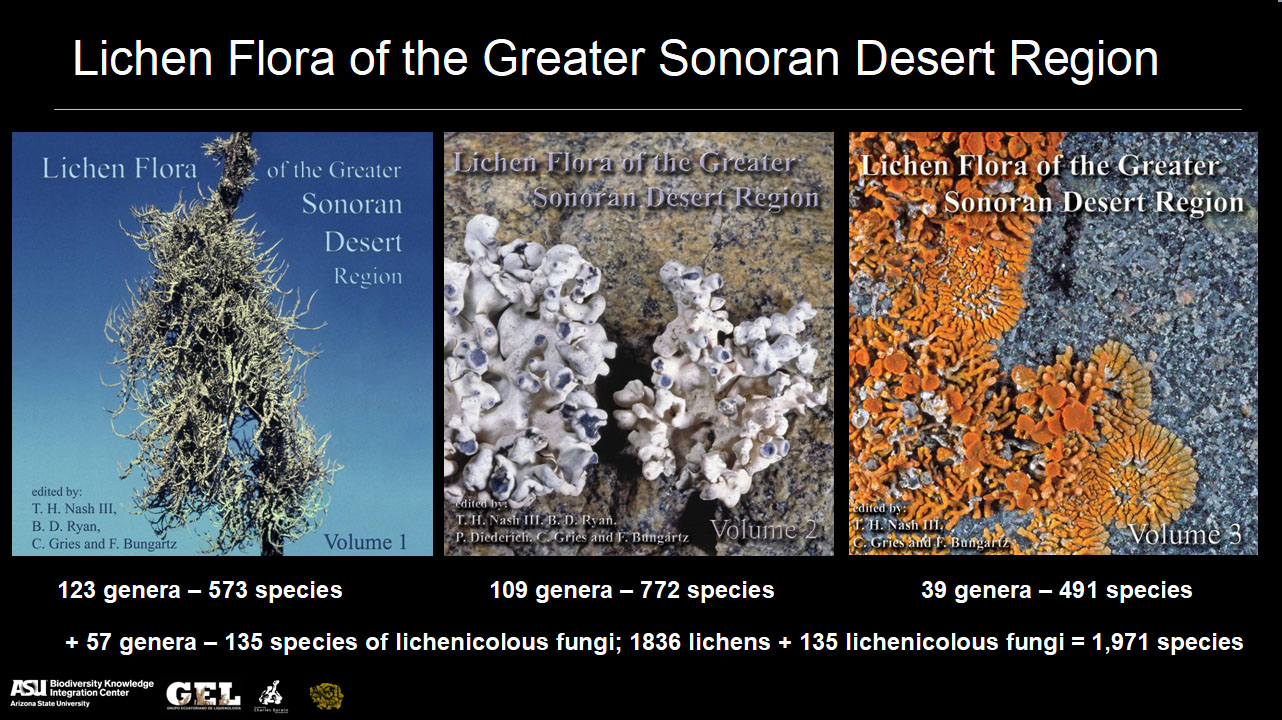Lichen Herbarium
The ASU Lichen Herbarium (ASU) is among the ten largest collections of lichenized fungi in the US; it contains some 125,000+ specimens (see our profile in the Consortium of Lichen Herbaria). The collection has a particularly strong focus on the Greater Sonoran Desert Region [40,000+ specimens are from this region, which includes northwestern Mexico: Baja California, Baja California Sur, Sonora, western Chihuahua and northern Sinaloa; and southwestern USA, Arizona, southern California].
The collection also includes specimens from across the United States, Canada, South America, Europe, Asia, Africa, Australia, and Antarctica. The lichen herbarium is open to the public and specimens are available for loan to researchers. All of the label data from ASU specimens are available in a searchable database on the Consortium of Lichen Herbaria.
Lichen specimens can be preserved for centuries if kept cool, dark, and dry. Lichen specimens are stored in paper envelopes that include a label indicating the name of the species, where and when it was collected, and the collector(s) who found it. Typically lichen specimens are sorted alphabetically by genus and species rather than by family since the taxonomic relationships of lichens are still poorly understood.
Learn about the amazing legacy of this collection.
Sonoran Lichen Diversity
Thanks to the legacy of Dr. Thomas H. Nash III and decades of biodiversity research across the region, the lichen diversity has been documented in three volumes of the Lichen Flora of the Greater Sonoran Desert Region:

What lichens are
Lichens are comprised of a fungus species and one or more species of green or blue-green algae, forming a symbiotic partnership. Fungal hyphae form the outer shell of the lichen and most of its internal structure, with algal cells interspersed among the hyphae. The fungus provides protection for the algae (especially in harsh, dry environments), while the algal partner produces food from photosynthesis. Taxonomists have named over 18,000 species of lichens (based on the fungal partner), but there may be as many as 250,000 species worldwide. Lichens are important ecologically for fixing atmospheric nitrogen and binding soil. They are also valuable to humans as sources of food, dyes, and drugs and as sensitive bio-indicators of pollution.
Here you can read an essay from Walter Fertig about Ten Things You Might Not Know About Lichens, But Wish You Did
Meet the collections staff
Please direct scientific inquiries to:
Frank Bungartz - Collections Manager of Lichens and Digital Data
phone: +1(480)465-0968
email: [email protected]
For specific questions about the collections (specimen records online, loans, etc.), please contact:
Frauke Ziemmeck - Curatorial Assistant, Lichen Herbarium
email: [email protected]
Visit our collection
Street Address: 734 West Alameda Drive, Tempe, AZ 85282
Hours: Monday - Friday: 9:00 am - 5:00 pm, or by appointment
For sending us loans please use the following PO Box (PLEASE NOTE - different area code !!!)
Some shipping companies insist using a street address, but our preferred way accepting shipments is the PO Box. The biocollections building shares the same street address with ASU's Mail Distribution Center. Shipments sent to the street address are therefore often not delivered correctly and we then have to trace them down. If you can afford it (especially for international shipments) always use a delivery option with a tracking number and send us an email notifying us of the impeding arrival of your shipment:
Dr. Frank Bungartz
Collections Manager of Lichens and Digital Data
ASU Natural History Collections, Lichen Herbarium
PO Box 874108
Tempe, AZ 85287-4108
USA
